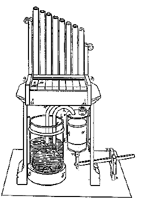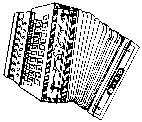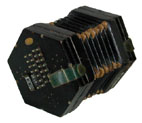|




























| |
          
|
The accordion has a long history and in order to
understand it, one must look at the main components that
make up the accordion. These parts include the reeds,
bellows, keyboard and bass section. Tracing back these
parts will help uncover the interesting evolution of the
accordion.
|
|
The musical instrument that started it all was an ancient
Chinese wind instrument known as the Cheng or Sheng. The
Cheng plays by blowing air into the wooden mouthpiece that
attaches to a gourd and into which are fitted various
amounts of bamboo shoots of different lengths. It was
invented as an imitation of the Phoenix bird. The
approximate date that this instrument was created is
unknown, but it is believed to be more then 2,000 years old.
The Cheng represents the free reed part of the accordion. A
reed is an elastic-like tongue of steel set within a metal
frame that pulsates "freely" by vibrating through a stream
of air. By changing the mass and size of the tongue you can
acquire different quality of tones and pitches.
|
|
|
Bellows were put on the accordion to substitute blowing air
by the mouth. This allowed stronger air pressure and
conserved the musician's energy. Greeks and Egyptians first
used bellows around 1500 B.C to heat up furnaces in forges
and portable bellow-like organs have been found in many
dated pictures.
|
|
The first keyboard instrument was a pipe organ called the
Hydraulus; this existed in ancient Greek and Roman times.
The Hydraulus used water pressure to regulate airflow.
Although it had a very simple keyboard, the Hydraulus helped
pave the way for many other organ type instruments and it is
believed to be one of the ancestors that helped build the
foundation of the accordion.
|
 |
 |
The accordion was initially based on the principle of the
harmonica or known to some as a mouth organ. When played,
one tone sounds after blowing and another tone after drawing
air. This is referred to as the diatonic system. Diatonic
accordions usually come in certain combinations of keys and
are mostly used for folk music.
|
|
There has been some controversy over who actually invented
the accordion. Although Cyrillus Damian of Vienna is often
attributed for its creation, it is now believed that
Friedrich Buschmann of Berlin was the first person to build
the basic model of the accordion in 1822. However, it was
Damian who actually patented the name "accordion" in 1829.
Early prototypes had no bass on the left hand; it wasn't
until later that it was added on.
|
 |
 |
In 1829, Sir Charles Wheatstone of England invented what he
called the "Symphonion with Bellows." His instrument had a
single tone for every button and played all the notes in a
scale. However, in 1833 he renamed it "concertina." The
reeds were originally made of brass, but are now made of
steel.
|
|
As you can see the accordion was developed
through the creation of many other instruments and today it
comes in many different types and sizes. Parts of the accordion
such as the registers, reeds, basses or keys can vary depending
on what the player's wants and needs are. An accordion can even
be amplified through a pick-up or electronically altered through
a midi to create hundreds of sounds. When played with a group or
on its' own as a one-man-band, the accordion has entertained
people for more then a century with its vibrant and elegant
sound. |
|
|